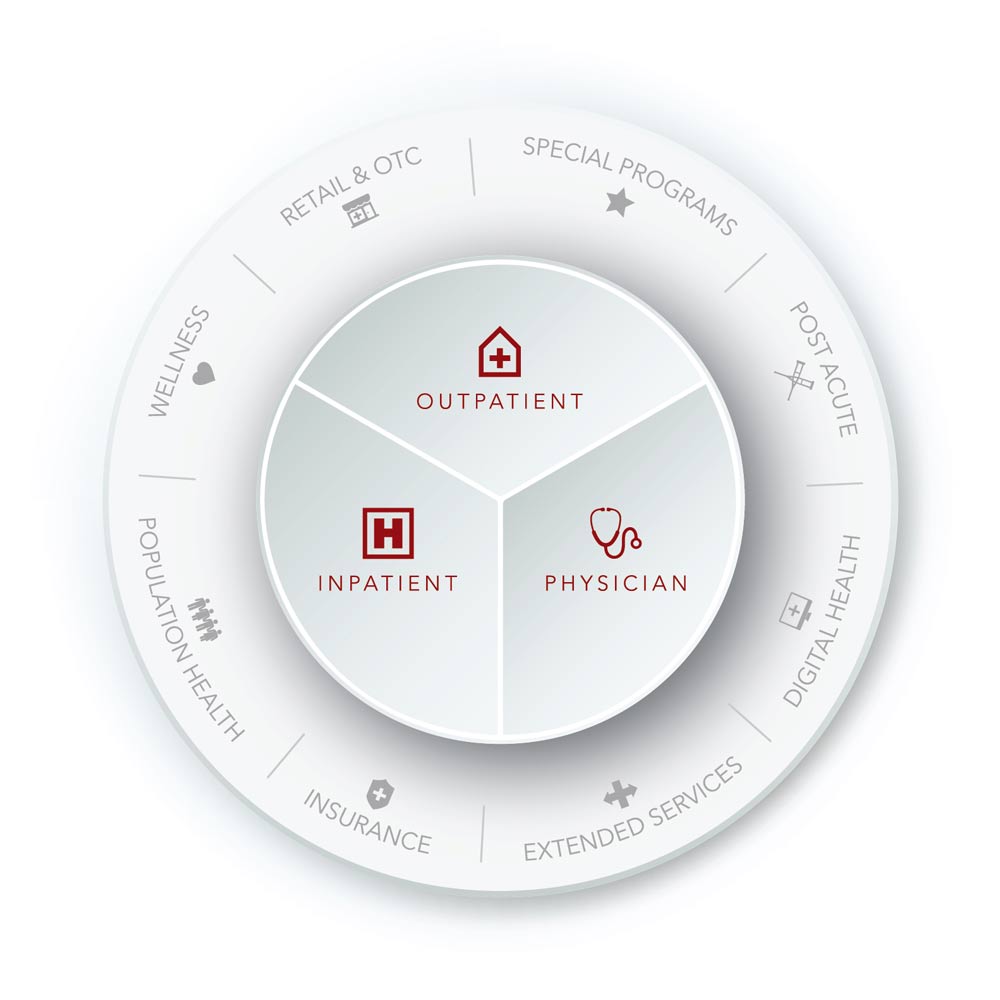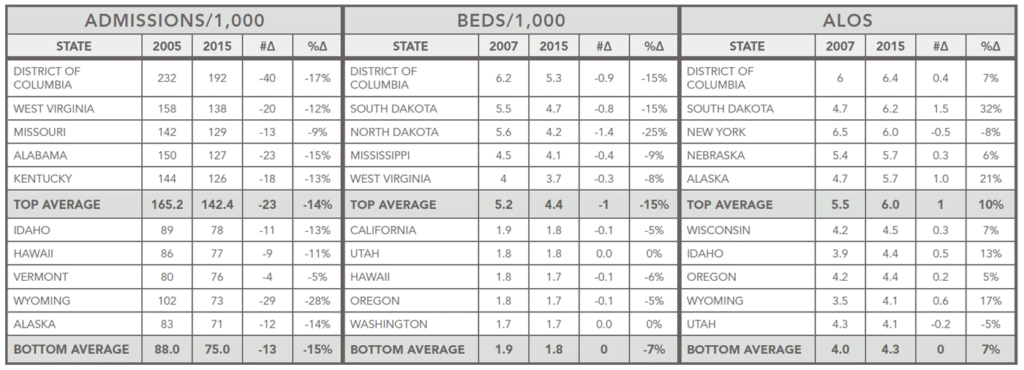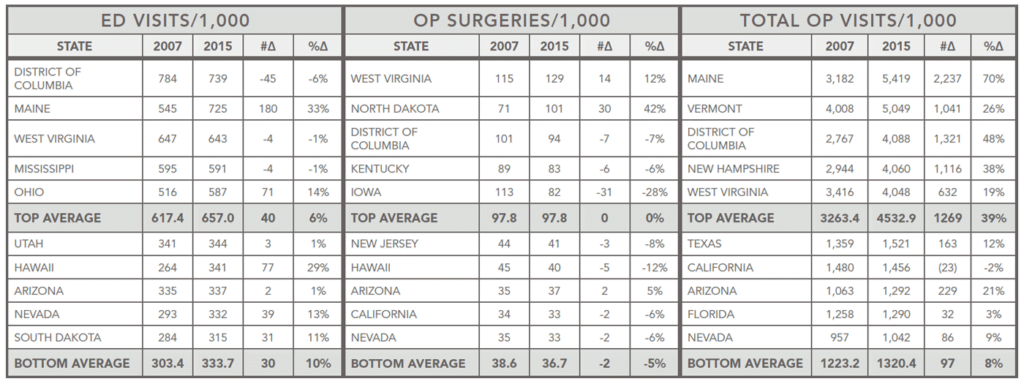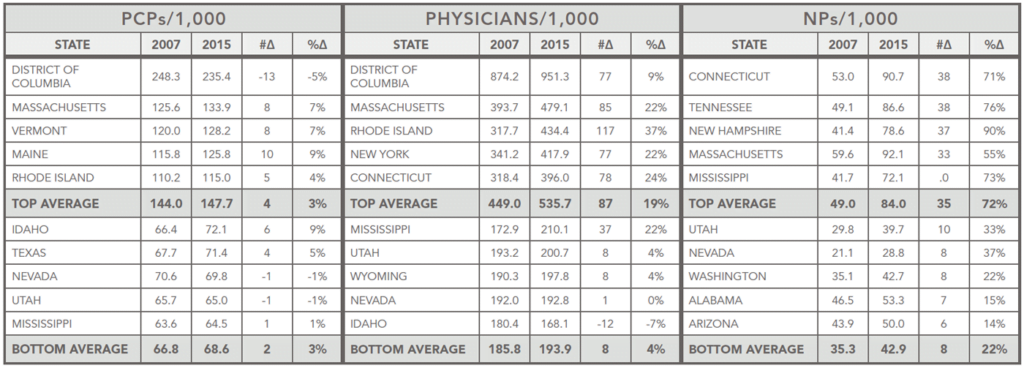Part One of ERDMAN’s Two-Part Series on How Planning for Hospitals Will Change in Coming Years
Background
Historically, demand forecasting for hospitals has been relatively predictable, based on the demography in a community, its population growth and historic mortality rates. However, in light of recent dynamics influencing the healthcare industry, this straightforward approach is no longer sufficient. In our view, four factors are reshaping demand for hospital services and prompting leadership to reassess their forecasts:
- Clinical innovation: The scale and scope of hospital services is expanding as clinical advances—technologies, therapies, methods of care—alter the diagnosis and treatment of acute care needs and expand demand for outpatient services.
- Payment models: Private insurers, Medicare, Medicaid and large employers are aggressively negotiating hospital payments based on total costs of care and preferentially contracting with those that provide the lowest cost and best outcomes. This shift from volume to value requires hospitals to deploy services across virtual and physical settings based on efficiency optimization and enhanced clinical outcomes.
- Physician employment: According to Physicians Advocacy Institute, the number of physician practices owned by hospitals/health systems rose 86% between 2012 and 2015.1 As a result, in 2015, 38% of physicians were hospital-employed. This spike in employment adds a new layer to the operational and financial complexity of hospital planning but also enhances opportunities in coordinated care management and population health.
- Competition: Hospitals are increasingly faced with not only local competition but nontraditional or out-of-market competitors. Some employers and insurers are contracting for certain high-cost services with reputable, non-local health systems that offer package deals on pricing and guaranteed safety and quality. Investors are funding micro-hospitals, freestanding outpatient and urgent care centers, and management programs for patient populations that reduce local demand. Furthermore, hospital consolidation has resulted in super-regional health systems that compete across multiple markets as they expand the scale and scope of the services offered.
As a result, demand forecasting for hospitals is further complicated. And changes in the regulatory environment coupled with the pluralistic dynamics of consumer preferences and attitudes mean strategists must incorporate additional factors and consider higher levels of risk in appropriating capital and setting priorities.
ERDMAN offers hospital leaders a strategic perspective on changes to demand for new and existing services, based on our Advisory Services analytic models. In Part One of this Insights series, the focus is on inpatient, outpatient and physician services, comprising the core for most acute hospitals and health systems. Part Two will explore second-tier services that are harder to quantify but necessary to consider when assessing demand across the continuum.
FORECAST 2020

The Core: Inpatient, Outpatient, and Physician Services
The basic core services offered in America’s 4,900 hospitals and health systems are of three types:
- Acute services that involve a hospital admission.
- Outpatient services provided at diagnostic centers, ambulatory surgery, emergency services, wellness centers, community education facilities, rehabilitation facilities and others.
- Physician services provided by employed and contracted physicians.
The scale and scope of services beyond the core varies widely by organization based on their mission, market characteristics, access to capital and strategic plans. As acute hospitals consolidate, many have added post-acute providers to their portfolios, and approximately 90 also sponsor insurance programs.2 Academic medical centers include specialized facilities to accommodate their clinical research activities and medical education needs. Increasingly, hospitals are leveraging sophisticated digital and virtual health services to expand their organizational reach. And as physicians enter into long-term employment agreements with hospitals, the composition of a hospital’s “medical group” becomes a critical factor in expanding access to their services in physical and virtual settings.
In our view, some hospitals will operate successfully as strong community hospitals and health systems; others will transition to fully integrated systems of health. Demand forecasting for each model is increasingly complicated, and either is an appropriate destination for strategists.
HOSPITAL OF THE FUTURE | |||
|---|---|---|---|
FROM COMMUNITY HOSPITAL OR HEALTH SYSTEM | TO SYSTEMS OF HEALTH | ||
TODAY’S THINKING
Unit Costs Inpatient, Outpatient Services, Physician Services Medical Staff, Employed, ACO Safety, Outcomes Patient Experience, Allopathic Campus Orientation Facility Locations Affiliations Technology, Facilities for Inpatient, Outpatient Core Screenings, Social Services Annual Negotiation Reputation, IP-OP Location | OPERATIONAL DOMAINS
Cost Orientation Business Unit Orientation Physician Organization Clinical Orientation Network Design Access Provider Network Capital Deployment Community Benefit Focus Insurer Orientation Value Proposition | FUTURE STATE OF THINKING
Total cost of care Acute, Primary, Post Acute, Retail + Insurance Exclusive Network + Alternative Providers Effectiveness, Efficiency, User Experience Regional Sites of Care Facilities + Digital Connectivity Narrow, Formal Regional Hubs Social Determinants Partnerships Scale, Scope, Outcomes, Affordability, Locations | |
Demand forecasting for hospitals is more complicated than calibrating the shift from inpatient to outpatient care. Granted, most hospitals have seen a shift from inpatient to outpatient services. Between 2010 and 2014, the share of revenues coming from the inpatient services fell from 71% in 2010 to 60% in 2014, while the share of revenues from outpatient services increased from 21% to 27% during the same time period.3 But that’s not enough.
ERDMAN models incorporate the full array of primary, secondary and emergent factors necessary to measure demand strategically and appropriate capital to its highest and best use for forward-looking hospitals.

Forecasting Demand for Inpatient Services
For most hospitals, we project admission rates will shrink 25%. However, inpatient acute care will account for 35% of revenues as the population ages and inpatient programs are centralized in high volume locations. The primary factors that must be considered in forecasting inpatient demand are:
- Population Growth: In acute care, overall population growth is a key factor in demand analysis. Population growth varies widely across markets and regions, most notably shifts from rural to urban settings and from the northeast to southeast. The U.S. added more than 2.4 million people from 2015 to 2016, an increase in the estimated total population to 322,762,018.4
- Demographic Shifts: The aging of the population, income disparity and ethnicity are primary factors that impact forecasts for inpatient services. In 1950, the population aged 65 and older represented 8.1% of the total U.S. population. That percentage is projected to reach 20.2% by 2050. Aging and population growth are projected to account for 81% of the change in demand between 2010 and
2020.5 - Certificate of Need (CON) Requirements: Currently, 36 states and the District of Columbia control the supply of beds for inpatient care and diagnostic technologies through their CON requirements. There is a push in some states to revisit and even repeal CON laws.6
- Clinical Innovation: In most clinical service lines, the setting for care is shifting from inpatient to outpatient settings, from invasive to minimally or non-invasive interventions and in some cases, from management in outpatient settings to in-home and virtual settings. CMS has also revised its inpatient-only list to allow more procedures to be performed in outpatient settings. For example, in 2018, CMS is removing total knee arthroplasty from the inpatient-only list along with five other procedures because surgical techniques have been improved for lower-risk patients.
In addition to these four primary determinants of demand, other factors have been shown to impact utilization:
- Third Party Authorization: Third party payer authorization is a secondary but important factor: insurers, Medicare and Medicaid sponsors monitor standards of care appropriate to inpatient utilization. Given heightened transparency about unnecessary care (e.g. the Choosing Wisely campaign and others), and projected health cost increases, it is likely private insurers will toughen their utilization review (UR) protocols to disallow nonevidence-based admissions where a safe option is available.
- Concentration of Specialists: Per the Dartmouth Atlas, a higher density of specialists is associated with higher utilization of inpatient services.7 Recruiting physicians to non-urban areas remains a challenge; therefore, it is likely specialty concentration in metropolitan areas will drive demand from rural and non-urban settings.
Additionally, new models of patient care are chipping away at how hospitals derive substantial demand for their inpatient acute care services. Some examples:
- Micro-Hospitals: Micro-hospitals, currently operating in 19 states, are small-scale, 24-hour accessible inpatient facilities.8 Most are in underserved, urban markets or in rural communities too small to support a full-service facility. Micro-hospitals are less costly to build than large hospitals, have lower overhead costs and qualify to bill for (hospital-level) higher reimbursement rates, making them attractive to investors.
- Emergent Care Services: Traditionally, the hospital emergency room was responsible for 82% of unscheduled hospital admissions.9 But private investors are now operating independent, freestanding ERs and urgent care clinics (UCCs) geared to patient stabilization and deferral from inpatient care. There are 172 independent for-profit ERs operating today and even more independent UCCs, and both are seeing growth.10
- Digital Health: The ‘hospital at home’ is a care management model that leverages an organization’s digital capabilities to manage patients in their homes, thus avoiding admission. Used primarily for patients’ post-discharge from a hospital and those with manageable chronic conditions, these modalities reduce inpatient care demand substantially.
And while not readily measurable, in certain services lines, like cancer, some health systems have successfully attracted patients from outside their conventional service area. Outmigration to certain provider organizations is a trend likely to impact demand long-term.
Looking ahead, we expect admissions rates for most hospitals to shrink from 103.5/1,000 to as low as 78/1,000 by 2025, a drop of 25%, even as the acuity of patient populations increases.
- Local demand varies widely based on how national-level trends impact regions to different degrees. For example, demand for cardiologists will rise 51% in Nevada but only 5% in West Virginia between now and 2025, according to projections from one 2013 study.11
- The differences in the health of the population impact the priorities of local payers and providers and make variation unlikely to occur evenly across regions and specialties.


Forecasting Demand for Outpatient Services
Demand for outpatient services will expand 13% in the next seven years and be at least 45% of health system revenues. Hospitals will relocate urgent care, physician services with outpatient ancillary programs in strategic locations to expand access to the hospital’s services.
Demand for outpatient services will continue to increase, even in markets where population growth is negative. Three factors explain this trend:
SCOPE
Historically, hospitals’ outpatient services have been predominantly comprised of ambulatory surgery, laboratory, imaging, rehabilitative and emergency services. But most hospitals are now offering more including occupational medicine programs, pain clinics, behavioral health and addiction treatment, cardiac catheterization, wellness and alternative health, radiation therapy and much more.
Convenience
Convenient access to outpatient programs is a critical factor influencing utilization. Some outpatient services must be centrally located and near the main inpatient campus. But others afford optimal access if located in easily accessible community or retail settings. Increasingly, hospitals are creating strategically located “healthcare malls” focused on accommodating demand for urgent care, sleep testing, retail pharmacy, occupational health, pain clinics, and other less traditional services in one convenient location.
Competition
Private investors are actively investing in outpatient programs and facilities. Some offer joint venture relationships with physicians and hospitals. Others develop independent facilities in attractive communities where insurers are willing to contract. These deals include lab, urgent care, imaging, behavioral health, ambulatory surgery, dermatology, pain management and others. In these, the investor capitalizes the venture and typically shares in profits with sponsors.
Predicting demand for outpatient services is more complex than predicting demand for inpatient services. Simple supply-demand models are unable to account for the vast number of influencing factors and the competitive landscape is far more complicated. The promise of telemedicine has potential to dampen volume growth, but it’s too early to know. What is clear is that the volume of outpatient activity is growing and the scope of outpatient services sponsored by hospitals is likely to expand.

We anticipate outpatient visits will increase as much as 13% by 2025, while the scale and scope of services offered expands. It is also clear that demand will vary widely from state to state based on populations served and the competitive climate for outpatient care.


Forecasting Demand for Physician Services
Forecasting demand for physician services is more problematic than forecasts for inpatient and outpatient services for two reasons:
- Physician practice patterns and in-office capabilities vary widely. Laws restricting private inurement and self-referrals are limiting factors and, in many specialties, demand is accommodated by incorporating mid-level professionals. Much of the demand for physician services is mitigated by utilization of alternative health providers (homeopathy, et al) and the use of clinics operated by mid-level practitioners (retail clinics, birthing centers, et al). Therefore, a forecast of demand for physician services is, at best, a barometer of local utilization rates and patient preferences rather than a definitive calculus based on disease prevalence.
- Accurately calculating supply and demand for physicians based on industry data is problematic. Forecasts by medical societies and public agencies (AAGME, AAMC, et al) do not consider the impact of mid-level practitioners, technologies that enable virtual visits or distance medicine. And these models discount the potential for individuals to self-diagnose, incentives for physicians to optimize outcomes while reducing costs and alternative therapies offered by nontraditional providers.
For these reasons, we believe demand forecasting for physician requires a deep understanding of a market’s unique population dynamics, regulatory constraints and competitive landscape.
ERDMAN’s conclusion is, at a national level, demand for physicians and mid-level professionals will increase as care management shifts to outpatient, home-based and virtual care settings. Shortages in some specialties, such as primary care, women’s health and others, will be mitigated by expanded use of advanced practice nurses, nurse practitioners (NPs) and physician assistants (PAs). Demand for physician services, therefore, must be factored against the supply of mid-level providers and the scope of practice they’re permitted to offer in each state. Consider:
- ERDMAN projects the supply of primary care NPs to increase by 30%, from 55,400 in 2010 to 72,100 in 2020. The supply of primary care PAs is projected to increase by 58%, from 27,700 to 43,900 over the same period.
- Supposing that NPs and PAs provide the same mix of services in 2020 they provided in 2010, the combined demand for NPs and PAs would increase by 17%. If NPs and PAs are used to provide a greater proportion of primary care services, their projected demand will be higher.
- If NP and PA supply is “effectively integrated,” the shortage of 20,400 physicians in 2020 could be reduced to 6,400 PCPs. If fully utilized, the percentage of primary care services provided by NPs and PAs will grow from 23% in 2010 to 28% in 2020.
- The benefits of using mid-level providers is recognized by states led by both Republicans and Democrats. There has been an increase in legislative actions and regulatory efforts to ease scope-of-practice laws making it easier to access nurse practitioners and physician assistants. And, NP and PA interest groups are stepping-up lobbying efforts so patient demand is met.12, 13
While the supply of physicians will increase 21% in the next decade, the supply of primary care clinicians will increase less than 5%. The reality is that primary care services will be accommodated in the future by a combination of mid-level professionals in tandem with new methods of digital health. And speculation is growing that pharmacists might play a larger role to complement the retail clinics hosted in 2,800 retail pharmacies nationwide.


Key Takeaways
Forecasting demand in the three core areas requires analytics beyond traditional demography, population growth and disease incidence. Accurate forecasting requires precision in analytics for primary, secondary, and emergent factors in the three core domains of service. Failure to capture relevant data completely, assess it objectively and plan accordingly is risky. ERDMAN’s analytic capabilities provides a verifiable basis for gauging demand accurately and setting priorities for clinical programs, facilities and competitive positioning. Our approach is straightforward:
- Data-driven insight: ERDMAN partners with providers across the country who appreciate the importance of data-driven decision making. Our robust analytics capability enables our clients to confidently plan for their future and features best-in-class geospatial analytics, inpatient and outpatient claims, and comprehensive provider inventories with patient-level data and industry expertise.
- Wide lens perspective: At ERDMAN, we believe that the questions about new service offerings, population health, patient experience, new care models, and facilities are not separate, isolated challenges. We believe that by looking at these through multiple perspectives simultaneously, organizations develop more effective and efficient solutions. ERDMAN’s commitment to Integrative Thinking™ enables our clients to address complex challenges with confidence and focus.
Our mission is to support strategic planning for hospitals as a partner and, in concert with strategists and planners, optimize the scale, scope, organization and impact of services offered based on a realistic, verifiable assessment of opportunities while minimizing capital, and reputational and operational risks. Locations and facilities matter, but more fundamental are the plans by which they are integrated to result in a sustainable future for the hospital.
- Physician Advocacy Institute. (Nov. 1, 2017). “Implications of Hospital Employment of Physicians on Medicare & Beneficiaries.” Analysis by Avalere Health, LLC. Retrieved from http://www.physiciansadvocacyinstitute.org/Portals/0/assets/docs/PAI_Medicare%20Cost%20Analysis%20–%20FINAL%2011_9_17.pdf.
- American Hospital Association. “Providers with health plans.” Retrieved from http://www.aha.org/about/membership/value-healthplans.shtml.
- Medicare Payment Advisory Commission (MedPAC). (Mar. 2016). “Chapter 3: Hospital inpatient and outpatient services: Assessing payment adequacy and updating payments.” Report to the Congress: Medicare Payment Policy, March 2016. Retrieved from
http://www.medpac.gov/docs/default-source/reports/chapter-3-hospital-inpatient-and-outpatient-services-march-2016-report-.pdf?sfvrsn=0. - He, W., Goodkind, D., & Kowal, P. R. (2016). “An aging world: 2015.” United States Census Bureau. https://www.census.gov/content/dam/Census/library/publications/2016/demo/p95-16-1.pdf.
- HRSA Health Workforce. (Oct 2016). “Projecting the supply and demand for primary care practitioners through 2020.” Retrieved from
https://bhw.hrsa.gov/health-workforce-analysis/primary-care-2020. - National Conference of State Legislatures. (Aug. 2016). “CON-Certificate of Need state laws.” Retrieved from http://www.ncsl.org/research/health/con-certificate-of-need-state-laws.aspx.
- Steen, J. “The Dartmouth Atlas on Roemer’s Law.” http://ahpanet.org/files/TheDartmouthAtlasonRoemer’sLaw%20b.pdf.
- Mirza, A. (Apr. 24, 2017). “Micro-hospitals provide health care closer to home.” U.S. News and World Report. Retrieved from
https://www.usnews.com/news/healthcare-of-tomorrow/articles/2017-04-24/micro-hospitals-offer-an-alternative-health-care-model-for-local-communities. - American College of Emergency Physicians (ACEP). (June 20, 2013). “Most unscheduled hospital admissions now come through ER.” ACEP Newsroom. Retrieved from http://newsroom.acep.org/2013-06-20-Most-Unscheduled-Hospital-Admissions-Now-Come-Through-ER.
- Zane, R.D.; Harish, N.; Wiler, J.L. (Oct. 24, 2016). “How the freestanding emergency department boom can help patients.” NEJM Catalyst. Retrieved from https://catalyst.nejm.org/how-the-freestanding-emergency-department-boom-can-help-patients/
- Green, L. V., Savin, S., & Lu, Y. (2013). “Primary care physician shortages could be eliminated through use of teams, nonphysicians, and electronic communication.” Health Affairs, 32(1), 11-19. Retrieved from http://content.healthaffairs.org/content/32/1/11.
- National Conference of State Legislatures. (Sep. 1, 2017). “Scope of practice legislative database archives (2011-2013).” Retrieved from http://www.ncsl.org/research/health/scope-of-practice-overview.aspx.
- J. Corley. (March 16, 2017). “Advanced-practice providers are key to America’s healthcare future” Forbes. Retrieved from
https://www.forbes.com/sites/realspin/2017/03/16/advanced-practice-providers-are-key-to-americas-healthcare-future/#706ca87d5998.



